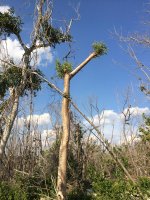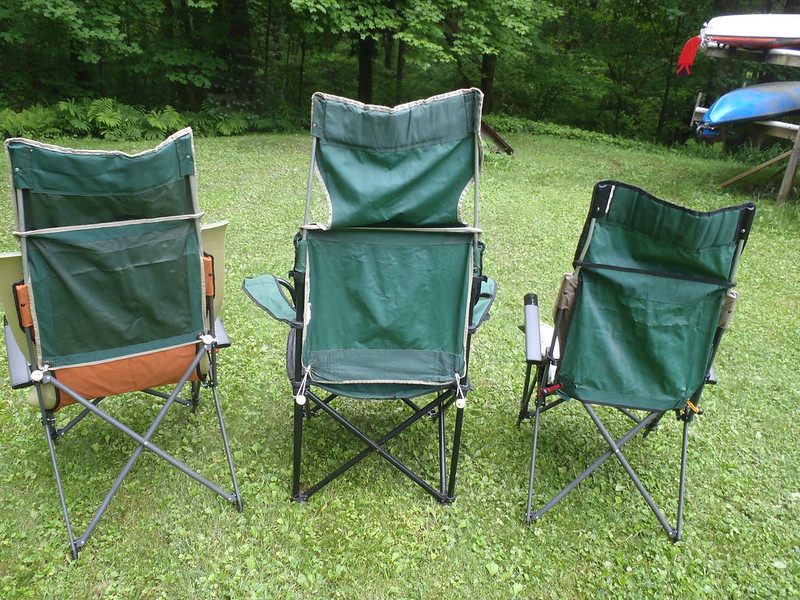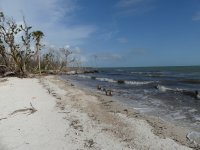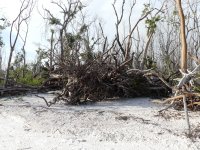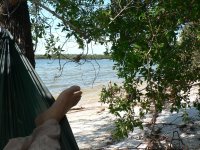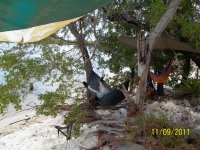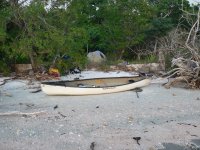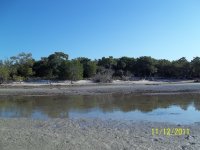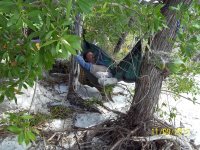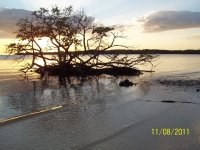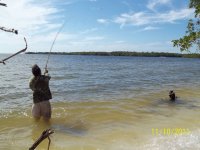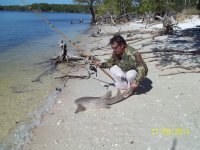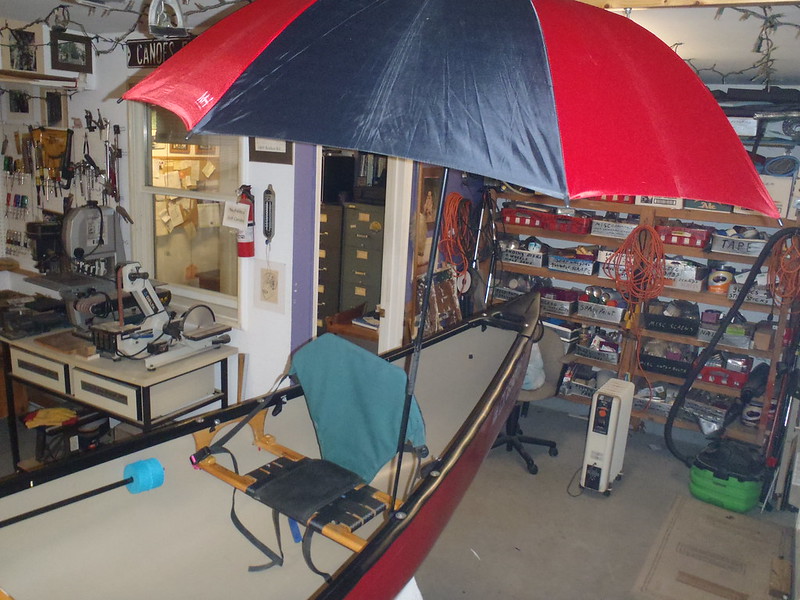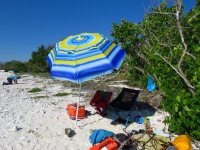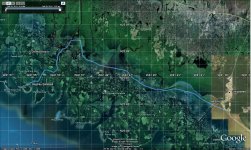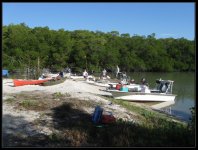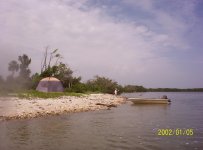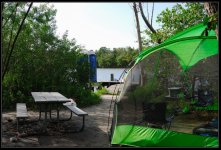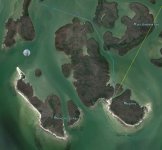- Joined
- Nov 30, 2017
- Messages
- 699
- Reaction score
- 439
The Ten Thousand Islands
In April, we took a short trip into the Ten Thousands Islands. We left from the put-in at Collier-Seminole State Park and followed the tide out into the Islands. (The Blackwater River here is tidal all the way to the boat ramp.) The banks are lined with Red Mangroves. Motors are permitted; we saw no "no wake" signs. We also saw no other boats except a couple of kayakers at the ramp. We peeled off into Gator Creek and then up Fish Hawk Creek and out into the Islands. We camped on Hog Key, which has been our favorite for many years because, at least previously, it had long mudflats and shallows surrounding it and motor boats did not come close. Not anymore. Which me to the first notable aspect worth highlighting: the devastation wreaked by Hurricane Irma.
We had actually noticed the damage on Blackwater River, but somehow it was more impressive out on the Islands. Scientific reports out of Miami stated that 40% of the mangroves were killed in the storm which swept right through the Ten Thousands Islands. From our viewpoint on the water, it looked like a much higher percentage were destroyed. Mile after mile of dead mangroves, poised like bony demons over the water. For those of you not familiar with the subtropics, mangroves perform two critical functions; shoreline stabilization and as a nursery for all the saltwater fish, shrimp, and other critters living in the salt water. The tropical and subtropical mangroves form a band around the entire earth.
Hog Key was almost unrecognizable. No more mud flats, so motorized fishing boats passed regularly in front of our camp. The sentinel mangrove and it's small point of land were totally gone. The forest of sea grapes was gone. Not just 'down' - gone; as if it never existed. Many of the remaining trees had been uprooted and blown down. The narrow but feisty channel between Hog Island and the mangrove swamp to the west was gone, entirely filled in. The large flat sandbank on the lee side of the island, popular with groups of kayakers for picnics and day gatherings, was still there, but....the former sand bank was entirely covered with a dense pasture of knee high grasses.
In ecological systems, change is not all bad. It is, in fact, normal and we saw evidence of this as well. On some mangrove flats, thousands of newly sprouted mangrove seedlings had sprung up under their dead parental stock. Mangroves are used to being battered, and some gnarly old trees were pushing out impossible new growth. Opening up the canopy on Hog Island changed the composition of the plant and animal life on the island. There were many more songbirds; mockingbirds, song sparrows, red-bellied woodpeckers and others I did not recognize. I found 12 new-to-the-island species of understory plants; scorpion tail, moon vine, morning glories and many I was not acquainted with. Strangest of all, perhaps, was the presence of large, fully mature Gumbo Limbos. Also known as the Tourist Tree (because its bark is orange and peeling), it is one of my favorite trees because of its nifty name, graceful shape and colorful bark. Gulf side of the island had a major log jam of downed gumbo limbos and, strikingly, many still upright. Though stripped of leaves and branches, they were beginning to leaf out again. Where did they come from, we wondered? The upright trees still had some soil and seemed to have been dumped in place at the edge of the island. Perhaps they were picked up by a tornado and dropped down.
Another effect of the storm is to effectively eliminate shade. What trees that are left have been stripped bare, leaving only little puddles of shade that move throughout the day. We used to hang hammocks in the shade and laze about comfortably even in midday sun. We still hung the hammocks. Tarps offered some protection from the blazing sun, but also cut down on the cooling breeze. Perfect conditions for heat illness and what amazed me is how fast it happened.
We arrived on Saturday morning and Sunday morning we went out fishing early, around 7 am. The sky was sapphire. The clouds were pearly. We floated bait over beds of silky sea grass. Brad caught several salt catfish - fun on the line, nasty getting off the line. I had one solid strike and that was it. But such a beautiful morning, how could one complain.? We saw dolphins and rays, ospreys and cormorants. And one winter loon. As the sun rose, a flotilla of candy colored kayaks went by, each day tripper talking louder than the next. We greeted them pleasantly and went in to the island. I had brought about a quart of powerade on our little fishing jaunt; the bottles were long empty. Got back to camp and drank more. I was hot. I was very hot. I sat up on a naked branch in a puddle of shade and tried to catch my breath. Inside, I am not happy. I feel terrible. But, I am not going to wimp out on this. I do not like whiners, especially if it's me. Finally, I asked Brad how he was feeling. He said he was hot, but he was enjoying the trip. I sat in silence. Was I really going to wimp out? If he can take it, I can take it too, I said to myself as I dove for the hammock under the tarp. A few minutes lying in the shade and I'll be fine. Well, I wasn't fine. I got hotter and hotter. I started stripping off clothes. Each piece of cloth touching me felt like fire. I wanted to jump in the water, but was unsure if salt water would make the problem worse. I asked Brad to bring me some water and I drank and drank. No improvement. I poured the water over me and asked for more. I began to feel feverish. By this time, Brad realized something was going on and having been trained as a first responder, he took over my care. I got a kerchiefs soaked with air temperature water and placed one over my face. I poured water over my hair and stuffed wet fabric under my armpits and between my legs. We replaced these as they got warm. He sat next to me on a camp chair and was perfectly calm. Brad estimates it took 45 minutes to an hour of cool compresses before the "fever" broke. After that I was hot, but not feverish, graduated to cold water from the ice chest and eventually felt more or less normal again.
Once I recovered, my thoughts ran to preventing future episodes. Although I had only experienced "only" heat exhaustion and not heat stroke, I was clearly on my way with a rising internal temperature. The experience was unpleasant and not worth repeating. I had hydrated plenty that morning, but Brad pointed out I had not drunk much the day before. With very warm temperatures (mid-90s) and a steady sea breeze, you never sweat. So there is no way to "notice" that you aren't sweating anymore (one of the signs of heat illness.) With no deep shade, there was no refuge from the heat of the sun and the radiant heat moved right through the tarps. The speed at which the heat problems developed was very fast. I think it was less than 15 minutes before realizing I was hot, and then too way too hot.
Since then, I have referred to my medical bible Medicine for Mountaineering. From this resource, I learned that the average skin temperature is 95 F. So if the air temp is 95 or over, there is no cooling via radiation. It was quite likely mid-90s or higher that day. When the humidity is high, there is also impaired cooling via evaporation. Humidity was probably high. In retrospect, I was also taking two medications that can increase risk of heat illness; an anticholinergic and a diruretic. The treatment for heat illness is the application of cool cloths and getting out of the sun. Medicine for Mountaineering also notes that heat stroke is one of the few medical emergencies in which a delay of a few minutes may "significantly alter the outcome." Heat stroke, the most severe form of heat illness can be fatal or survivors may have permanent disabilities.
We decided to cut the trip short and return home. Although I was "normal" again, the experience was exhausting and my body was totally worn out. We picked up and went in with the tide the next morning.
Erica
In April, we took a short trip into the Ten Thousands Islands. We left from the put-in at Collier-Seminole State Park and followed the tide out into the Islands. (The Blackwater River here is tidal all the way to the boat ramp.) The banks are lined with Red Mangroves. Motors are permitted; we saw no "no wake" signs. We also saw no other boats except a couple of kayakers at the ramp. We peeled off into Gator Creek and then up Fish Hawk Creek and out into the Islands. We camped on Hog Key, which has been our favorite for many years because, at least previously, it had long mudflats and shallows surrounding it and motor boats did not come close. Not anymore. Which me to the first notable aspect worth highlighting: the devastation wreaked by Hurricane Irma.
We had actually noticed the damage on Blackwater River, but somehow it was more impressive out on the Islands. Scientific reports out of Miami stated that 40% of the mangroves were killed in the storm which swept right through the Ten Thousands Islands. From our viewpoint on the water, it looked like a much higher percentage were destroyed. Mile after mile of dead mangroves, poised like bony demons over the water. For those of you not familiar with the subtropics, mangroves perform two critical functions; shoreline stabilization and as a nursery for all the saltwater fish, shrimp, and other critters living in the salt water. The tropical and subtropical mangroves form a band around the entire earth.
Hog Key was almost unrecognizable. No more mud flats, so motorized fishing boats passed regularly in front of our camp. The sentinel mangrove and it's small point of land were totally gone. The forest of sea grapes was gone. Not just 'down' - gone; as if it never existed. Many of the remaining trees had been uprooted and blown down. The narrow but feisty channel between Hog Island and the mangrove swamp to the west was gone, entirely filled in. The large flat sandbank on the lee side of the island, popular with groups of kayakers for picnics and day gatherings, was still there, but....the former sand bank was entirely covered with a dense pasture of knee high grasses.
In ecological systems, change is not all bad. It is, in fact, normal and we saw evidence of this as well. On some mangrove flats, thousands of newly sprouted mangrove seedlings had sprung up under their dead parental stock. Mangroves are used to being battered, and some gnarly old trees were pushing out impossible new growth. Opening up the canopy on Hog Island changed the composition of the plant and animal life on the island. There were many more songbirds; mockingbirds, song sparrows, red-bellied woodpeckers and others I did not recognize. I found 12 new-to-the-island species of understory plants; scorpion tail, moon vine, morning glories and many I was not acquainted with. Strangest of all, perhaps, was the presence of large, fully mature Gumbo Limbos. Also known as the Tourist Tree (because its bark is orange and peeling), it is one of my favorite trees because of its nifty name, graceful shape and colorful bark. Gulf side of the island had a major log jam of downed gumbo limbos and, strikingly, many still upright. Though stripped of leaves and branches, they were beginning to leaf out again. Where did they come from, we wondered? The upright trees still had some soil and seemed to have been dumped in place at the edge of the island. Perhaps they were picked up by a tornado and dropped down.
Another effect of the storm is to effectively eliminate shade. What trees that are left have been stripped bare, leaving only little puddles of shade that move throughout the day. We used to hang hammocks in the shade and laze about comfortably even in midday sun. We still hung the hammocks. Tarps offered some protection from the blazing sun, but also cut down on the cooling breeze. Perfect conditions for heat illness and what amazed me is how fast it happened.
We arrived on Saturday morning and Sunday morning we went out fishing early, around 7 am. The sky was sapphire. The clouds were pearly. We floated bait over beds of silky sea grass. Brad caught several salt catfish - fun on the line, nasty getting off the line. I had one solid strike and that was it. But such a beautiful morning, how could one complain.? We saw dolphins and rays, ospreys and cormorants. And one winter loon. As the sun rose, a flotilla of candy colored kayaks went by, each day tripper talking louder than the next. We greeted them pleasantly and went in to the island. I had brought about a quart of powerade on our little fishing jaunt; the bottles were long empty. Got back to camp and drank more. I was hot. I was very hot. I sat up on a naked branch in a puddle of shade and tried to catch my breath. Inside, I am not happy. I feel terrible. But, I am not going to wimp out on this. I do not like whiners, especially if it's me. Finally, I asked Brad how he was feeling. He said he was hot, but he was enjoying the trip. I sat in silence. Was I really going to wimp out? If he can take it, I can take it too, I said to myself as I dove for the hammock under the tarp. A few minutes lying in the shade and I'll be fine. Well, I wasn't fine. I got hotter and hotter. I started stripping off clothes. Each piece of cloth touching me felt like fire. I wanted to jump in the water, but was unsure if salt water would make the problem worse. I asked Brad to bring me some water and I drank and drank. No improvement. I poured the water over me and asked for more. I began to feel feverish. By this time, Brad realized something was going on and having been trained as a first responder, he took over my care. I got a kerchiefs soaked with air temperature water and placed one over my face. I poured water over my hair and stuffed wet fabric under my armpits and between my legs. We replaced these as they got warm. He sat next to me on a camp chair and was perfectly calm. Brad estimates it took 45 minutes to an hour of cool compresses before the "fever" broke. After that I was hot, but not feverish, graduated to cold water from the ice chest and eventually felt more or less normal again.
Once I recovered, my thoughts ran to preventing future episodes. Although I had only experienced "only" heat exhaustion and not heat stroke, I was clearly on my way with a rising internal temperature. The experience was unpleasant and not worth repeating. I had hydrated plenty that morning, but Brad pointed out I had not drunk much the day before. With very warm temperatures (mid-90s) and a steady sea breeze, you never sweat. So there is no way to "notice" that you aren't sweating anymore (one of the signs of heat illness.) With no deep shade, there was no refuge from the heat of the sun and the radiant heat moved right through the tarps. The speed at which the heat problems developed was very fast. I think it was less than 15 minutes before realizing I was hot, and then too way too hot.
Since then, I have referred to my medical bible Medicine for Mountaineering. From this resource, I learned that the average skin temperature is 95 F. So if the air temp is 95 or over, there is no cooling via radiation. It was quite likely mid-90s or higher that day. When the humidity is high, there is also impaired cooling via evaporation. Humidity was probably high. In retrospect, I was also taking two medications that can increase risk of heat illness; an anticholinergic and a diruretic. The treatment for heat illness is the application of cool cloths and getting out of the sun. Medicine for Mountaineering also notes that heat stroke is one of the few medical emergencies in which a delay of a few minutes may "significantly alter the outcome." Heat stroke, the most severe form of heat illness can be fatal or survivors may have permanent disabilities.
We decided to cut the trip short and return home. Although I was "normal" again, the experience was exhausting and my body was totally worn out. We picked up and went in with the tide the next morning.
Erica

